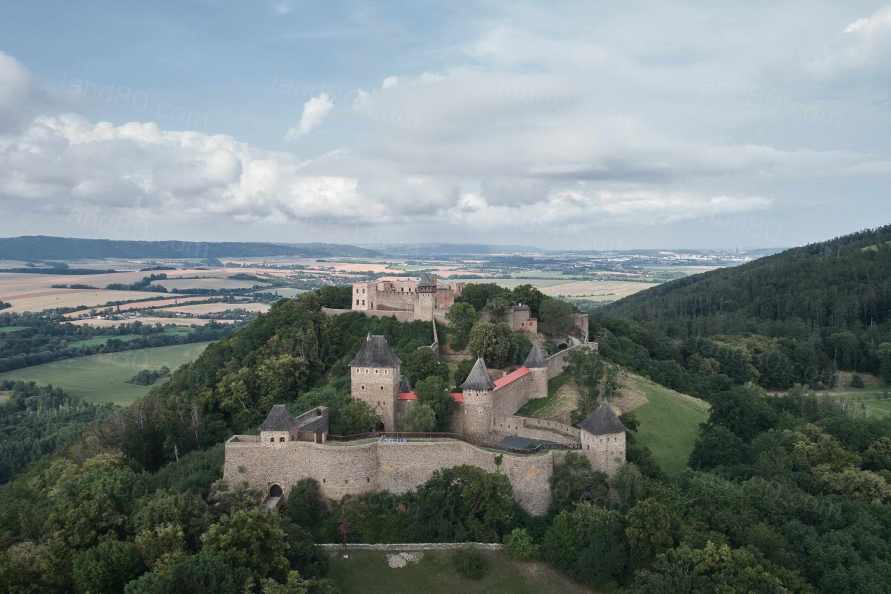文化遗产
Helfštýn城堡高高耸立在摩拉维亚门山谷之上,是捷克共和国仅次于布拉格城堡的第二大建筑群。Helfštýn建立于14世纪。2014年,文艺复兴时期的宫殿遗址因砖石掉落、遗迹退化等严重安全隐患而被迫关闭。
Cultural Heritage
Rising high above the Moravian Gate valley, Helfštýn Castle is the second largest complex in the Czech Republic right after Prague Castle. Helfštýn was established in the 14th century. In 2014 the Renaissance palace ruins had to close down due to the severe safety hazards such as falling masonry and remains degradation.




城堡所有者Olomouc市政府的首要要求是在修建新屋顶的同时对宫殿进行翻新,国家遗产研究所坚持在废墟的状态下保存建筑。屋顶只允许部分建造,而且只能建到外围墙壁的高度。项目规划相当独特。基于无人机拍摄的数千张照片的3D模型,让我们能够绘制出所有类型的石膏和砖石改造。
The primary requirement of the castle owner; Olomouc Region, was to renovate the palace along with the construction of a new roof. The National Heritage Institute insisted on the preservation of the building in the state of a ruin. The roof was allowed only partially, and it could only go as high as the level of the peripheral walls. The project planning was rather unique. The 3D model based on thousands of photographs from a drone allowed us to map all the types of plaster and masonry modifications.




新概念
我们渴望超越技术重建任务。我们努力将历史建筑与现代建筑相辅相成,既要注重实用性,又要获得美感。
New Concept
We aspired to go beyond the technical reconstruction assignment. We strived to compliment the historical building with the contemporary architecture that would focus on both practical use as well as gaining an aesthetic appeal.
为了让游客沉浸在原来文艺复兴时期宫殿的历史发展中,我们在废墟中已经存在的空间中插入了新的观光路线,将底层和新的宫殿高层连接起来。
In order to immerse the visitors in the historical development of the original renaissance palace we inserted new sightseeing routes into the already existing gaps in the ruins, connecting the ground floor with the newly accessible higher levels of the palace.
新增加的现代元素在历史建筑中清晰可辨。我们使用了三种基本材料,每层建筑各使用一种。屋顶由钢梁上的玻璃制成,楼梯和人行天桥由耐候钢制成,底层道路由抛光混凝土制成。
Newly added contemporary elements are clearly recognizable in the historical construction. We worked with three basic materials, one for each level of the building. The roofing is made of glass on steel beams, the staircases and footbridges have been made of corten steel and the ground floor paths are made of polished concrete.


玻璃屋顶
平坦的玻璃屋顶被插入到废墟的墙壁之间。在选择屋顶材料时,开阔的天空是关键的灵感来源。使用玻璃为宫殿内部提供了完美的日光条件。我们选择使用砂光玻璃,有几个原因。它易于维护,平坦的散射光与宫殿内的展览相得益彰。小教堂的屋顶是个例外。透明的玻璃屋顶相当地象征着天堂。
Glass Roof
The flat glass roofs have been inserted in between the walls of the ruins. The wide-open sky was the key inspiration when choosing the material for the roof. Using glass provides perfect day light conditions to the interior of the palace. We have chosen to work with the sanded glass for a couple of reasons. It is easy on the maintenance and the flat dispersed light compliments the exhibitions inside the palace. The chapel roof was an exception. The clear glass roof symbolizes heaven quite literally.
我们只在五个选定的房间里装了一个屋顶。铁皮人行天桥作为楼梯的屋顶。我们故意省略了一些空间,以增强遗迹的精神,并鼓励游客仰望天空。
We have put a roof on five chosen chambers only. The corten footbridges serve as a roof for the staircases. We intentionally left out some of the spaces in order to enhance the spirit of the impressive ruins and encourage the visitors to look up to the sky.

耐候钢人行桥
曾经的屋顶,现在成了新的观光路线。如此接近原来宫殿的建筑细节,并且和城墙顶部一样高,让公众可以欣赏到这一景象的历史意义和周围地区的纯粹景色。
Corten Footbridges
What once used to be a roof has now become the new sightseeing route. Being this close to the construction details of the original palace and as high as the top of the walls allows the public to admire the historical significance of the sight and the sheer views of the surrounding region.
选择一种永恒的材料至关重要。耐候钢是一种特殊的铁合金,它经过腐蚀、成熟,并与古老的历史城墙纹理相匹配。此外,Helfštýn 城堡以其铁艺传统而闻名,因此选择耐候钢材料进行施工是非常合理的。
It was crucial to choose a material that would be timeless. Corten is a special iron alloy that undergoes a corrosion, matures and matches the texture of the old historical walls. Moreover, Helfštýn Castle is well-renowned for its iron craftsmanship tradition, therefore it made a perfect sense to choose corten to work with.

混凝土小径
在底层,我们设计了一个由精确平滑的预制混凝土板铺成的行进区和人行道网络。预制混凝土由严格的直线型钢型材定义,与不平整和不规则的墙体形成一定的距离。精确的型材和不规则的墙体之间的区域由碎石倾倒,碎石突出了这两者,并以毫不妥协的直线前部调和了不规则。
Concrete Paths
On the ground floor we designed a network of marching areas and pavements from precise smooth pre-cast concrete boards laid down into individual areas. Pre-cast concrete is defined by rigorously straight Corten steel profiles that create a distance from uneven and irregular walls. The area between precise profile and irregular walls is dumped by gravel that highlights both and conciliates irregularity with uncompromising straight forefront.

过去和现在
我们的理念是以尊重历史建筑为基础,努力保持城堡的真实性。宫殿获得了一条有吸引力的观光路线,让游客了解建筑的历史,并从城堡上层的人行天桥上欣赏曾经是屋顶的风景。当代建筑并没有与历史建筑相竞争,而是形成了一个凝聚力很强的单元,所有的元素,新旧元素都在其中齐头并进。
Past and Present
Our concept is based on the respect towards the historical building and it pursues a major effort to preserve the castle’s authentic character. The palace gained an attractive sightseeing route that allows the visitors to learn about the building history and enjoy the picturesque views from the footbridges on the upper levels of the castle what once used to be a roof. The contemporary architecture does not compete with the historical building, rather it creates a cohesive unit in which all the elements, old and new go hand in hand.



Project name: Helfštýn Castle Palace Reconstruction
Basic description: Reconstruction and Renovation of Helfštýn Castle Palace
Studio: atelier-r
Author: Miroslav Pospíšil, principal architect
Contact E-mail: atelier-r@atelier-r.cz
Website: www.atelier-r.cz
Studio address: tř. Spojenců 748/20, 779 00 Olomouc, Czech Republic
Co-author: Martin Karlík, principal project manager
Project location: Helfštýn by Týn nad Bečvou
Project country: Czech Republic
Project year: 2015-2016
Completion year: 2020
Built-up Area: 1370 m2
Gross Floor Area: 3000 m2
Usable Floor Area: 1340 m2
Plot size: 2050 m2
Client: Olomouc Region
Client's e-mail: posta@olkraj.cz
Client's website: www.olkraj.cz
Design team: Robert Randys, Lucie Rohelová, Adéla Tomečková, Milena Koblihová, Daria Johanesová / atelier-r
Structural stability of historical constructions: Ladislav Klusáček, www.fce.vutbr.cz
Structural stability of newly inserted constructions: Jan Lukáš, www.lostade.cz
Rehabilitation of the damp parts of historical walls: Pavel Fára, www.cubus.cz
Contractors: HOCHTIEF CZ and ARCHATT PAMÁTKY
Steel and corten construction: Zámečnictví Sloupský
Glass construction: Bubeník 1913
Concrete floors: AAP hranice
Photographer: BoysPlayNice, info@boysplaynice.com, www.boysplaynice.com
|